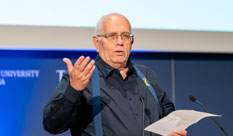More:
Events
Analysis Day II at HIT
The department of mathematics organizes conferences and seminars since 2003.
This is the 19th seminar which dealt with "Complex analysis".

Photo: Guy Tzuri
It was initiated by Prof. Anatoly Golberg, Head of the Department of Mathematics at the faculty of Sciences and Dr. Luna Elizarraras, senior lecturer from the department of mathematics, after a meeting they held with three leading lecturers from Italy and the USA at a conference in the USA. The three were invited to lecture at HIT.
The main topics of the seminar were Hyper- Complex Analysis and its applications.
Here are the abstracts of the lectures:
Daniele C. Struppa, Chapman University, Orange, USA
Superoscillations and Infinite Order Differential Operators
Abstract
Yakir Aharonov discovered, thirty years ago, a phenomenon in which a signal which is globally band limited can contain local segments that oscillate faster than its fastest Fourier transform. He appropriately used the term superoscillations to refer to this phenomenon. The phenomenon appears as consequence of the theory of weak values in quantum physics, and one of the fundamental questions that Aharonov posed was whether the superoscillatory phenomenon persists when evolved according to the Schrodinger equation. In a series of papers, the author together with Aharonov, Colombo, Sabadini, and Tollaksen, have developed a powerful method that utilizes infinite order differential operators (as well as convolution operators) to give an affirmative answer to the question of longevity of superoscillations. As of now, we have been able to apply this method to a very large class of potentials for the Schrodinger equation, and in this talk I will describe both the general method, as well as some of the specific cases we have studied in detail. As a byproduct of our work, we have also addressed a different question in the theory of superoscillations, namely the question of the construction of large classes of such phenomena. In the talk I will show how the two questions relate to each other.
Irene Sabadini, Politecnico di Milano, Milano, Italy
Some old and new results on possible notions of analyticity in hypercomplex algebras
Abstract
In collaboration with F. Colombo and D.C. Struppa we recently translated in English some old papers of M. Sce, see [1]. In these papers we found some ideas that are interesting per se, and might eventually lead to some new results in hypercomplex analysis. In this talk we illustrate some of these ideas and some further developments
[1] F. Colombo, I. Sabadini, D. C. Struppa, "Michele Sce's Works in Hypercomplex Analysis 1955-1973. A translation with commentaries", preprint, 2019.
Fabrizio Colombo, Politecnico di Milano, Milano, Italy
Direct and Inverse Fueter-Sce-Qian Mapping Theorem and Spectral Theories
Abstract
In classical complex operator theory, the Cauchy formula of holomorphic functions is a fundamental tool for defining functions of operators. Moreover, the Cauchy-Riemann operator factorizes the Laplace operator, so holomorphic functions play also a crucial role in harmonic analysis and in boundary value problems. In higher dimensions, for quaternion-valued functions or more in general for Clifford-algebra-valued functions, there appear two different notions of hyper-holomorphicity. The first one is called slice hyperholomorphicity and the second one is known under different names, depending on the dimension of the algebra and the range of the functions: Cauchy-Fueter regularity for quaternion-valued functions and monogenicity for Clifford-algebra-valued functions.
The Fueter-Sce-Qian mapping theorem reveals a fundamental relation between the different notions of hyperholomorphicity.
The generalization of holomorphicity to quaternion- or Clifford-algebra-valued functions produces two different notions of hyper-holomorphicity that are useful for different purposes and induce two spectral theories. Precisely, we have that:
- The Cauchy formula of slice hyperholomorphic functions leads to the definition of the $S$-spectrum and the $S$-functional calculus for quaternionic linear operators. Moreover, the spectral theorem for quaternionic linear operators is based on the $S$-spectrum.
- The Cauchy formula associated with Cauchy-Fueter regularity resp. monogenicity leads to the notion of monogenic spectrum and produces the Cauchy-Fueter functional calculus for quaternion-valued functions and the monogenic functional calculus for Clifford-algebra-valued functions. This theory has applications in harmonic analysis in higher dimension and in boundary.
Maria Elena Luna-Elizarrarás, Holon Institute of Technology, Holon, Israel
Liouville's theorem for multidimensional modules over hyperbolic scalars
Abstract
The main object of the talk is the set Dn:=D×L ×D where D stands for the real algebra of hyperbolic numbers. It is endowed with the norm and inner product taking values in hyperbolic numbers, thus the angles are also measured with the elements of D. We will speak briefly about an adequate notion of the conformality in this context and a description of the respective D-Möbius transformations will be presented. An analogue of the Liouville theorem says that any D-conformal mapping in Dn is a D - Möbius transformation.
The talk is based on a joint work with A. Golberg

Photo: Guy Tzuri
Posted: 22/01/2020
- News & Events
New Collaboration with Sheba Medical Center will qualify nurses to work in a digital environment.
Collaboration between HIT Holon Institute of Technology, the teaching authority of the Sheba Medical Center, and the Sheba-BEYOND virtual hospital will allow training nurses in Israel and around the world to work in a digital...



 Additional programs
Additional programs
